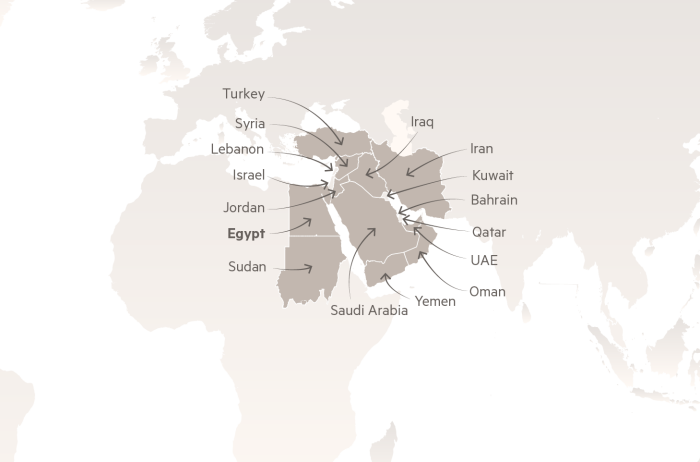Israel’s Econcrete offers greener foundation for coastal defences

Roula Khalaf, Editor of the FT, selects her favourite stories in this weekly newsletter.
Tiny shells cling to hunks of concrete bathing in a giant tank of seawater in a back room of Shimrit Perkol-Finkel’s Tel Aviv office. Concrete has become a mundane, ever-present aspect of modern life, but her company is seeking to “green the grey” by reducing its impact on the environment.
Econcrete, her start-up, is one of a handful of companies “eco-engineering” a more environmentally-friendly concrete for marine construction and artificial structures that promote the growth of sea life.
Rising average global temperatures are projected to cause sea levels to rise by 30cm by 2050, according to UN data, and coastal cities are expected to bear the brunt of rising seas and increasingly violent storms.
From New Orleans to London, cities have invested millions of dollars in infrastructure to fortify themselves against storm surges. Now designers are trying to harness nature to better protect human environments in a rapidly changing world.
“Coastal development is constantly on the rise,” says Ms Perkol-Finkel, a marine biologist and Econcrete’s chief executive. “They’re going to build . . . if you want it or not. Let’s try and build . . . better.”
The company has designed concrete for marine construction that it says is less harmful to the environment and encourages the coastal ecosystem, at only a marginal increase in cost at scale without undermining structural integrity.

Ms Perkol-Finkel founded Econcrete in 2012 with her former student-turned-business partner Ido Sella, developing the concept during her postdoctoral research on Red Sea coral reefs. Ronen Azouri, an Israeli venture capitalist and real estate developer, was a seed investor, while the Elah Fund, an Israeli venture capital group, is now the main investor.
“I wanted to do some experimentation on different aspects of reef design,” says Ms Perkol-Finkel. “How can we better mimic artificial reefs to be more similar to natural reef communities.” She embedded concrete tiles on jetties at a military facility in the Israeli coastal city of Eilat that were soon “booming with life”.

Coastal construction destroys habitats such as wetlands, mangrove swamps, oyster beds and coral reefs, which offer natural protection from flooding and storm surges. Concrete’s smooth surface and chemistry stifles marine life, leaving watery wastelands around humanity’s multiplying ports, marinas, offshore wind farms and breakwaters.
Such structures “tend to be poor quality habitats when they replace natural habitats,” says Ally Evans, an Aberystwyth university researcher involved with Ecostructure, a project in Wales and Ireland that promotes coastal defences that benefit the environment. “They support quite weedy species and only tough things can survive on them, and it tends to be because of the quite simple uniform design of the materials.”
Against this backdrop, Econcrete’s concepts are starting to attract interest from government authorities and developers. Last year, Econcrete installed 16 eco-engineered modules at the port of Rotterdam, while earlier this year Hong Kong launched a pilot programme using the company’s blocks and panels along the city’s shoreline and seawalls.

Econcrete is still “quite lean and mean,” Ms Perkol-Finkel says. Half of its employees work from its retrofitted industrial loft in central Tel Aviv that is part laboratory, part design studio, while the rest are in the US and Europe.
Tanks filled with different compositions of seawater — one simulating the Red Sea, another the Mediterranean — test concrete samples in various stages of encrustation by marine life, while next door engineers design moulds that mimic formations from the natural world such as tidepools, which molluscs, corals and other sea creatures need to survive.
Cement production is one of the leading generators of man-made carbon dioxide, and like other eco-friendly concrete manufacturers, Econcrete uses waste products such as fly ash and slag as a substitute for Portland cement, which has a higher carbon footprint due to increased energy use during its production.
Ms Perkol-Finkel says her company’s mixture has the additional benefit of encouraging the growth of oysters, corals, algae and other marine life on the concrete. These creatures encase the surface in calcium carbonate, which she says helps strengthen the structure and also acts as “an active carbon sink”.
“For each kilogramme of calcium carbonate that’s been created, we’re offsetting 120 grammes of CO2,” Ms Perkol-Finkel says. “All of these can translate into reduction in maintenance in the long run which can be a benefit from a financial perspective.

After raising $4.7m in seed funding in 2018, Econcrete is set to launch a second round and is shifting gears from research and development to demonstration sites for its product. Ms Perkol-Finkel declines to comment on the group’s estimated valuation and profitability, but says the group’s sales are growing.
But while companies such as Econcrete are making strides to improve how human development affects the natural world, marine ecologists such as Louise Firth from the University of Plymouth warn that these measures are no substitute for natural environments.
“If we allow ports, harbours, coastlines to continue to be built in the way of the past with no consideration of nature, we are in danger of driving further extinctions and reductions of biodiversity,” she says. “We cannot replace or mitigate what we lose when we build a permanent development. “We can only compensate for its loss.”
FT Future 25: Middle East
Supported by


Comments